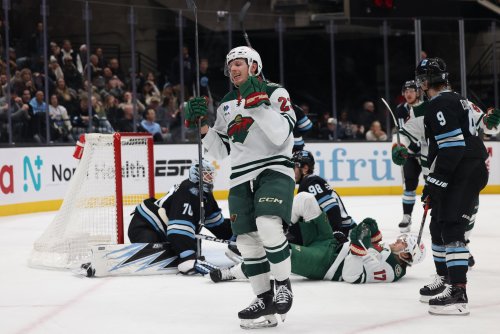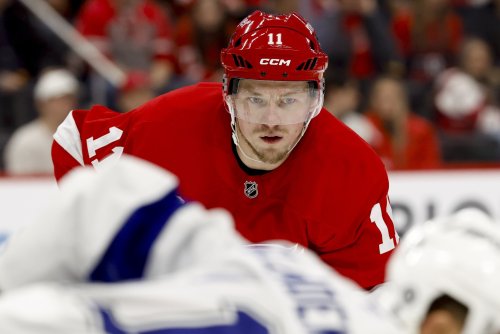
The Minnesota Wild’s days of navigating a cap crunch have come to an end. At least for this summer.
Days after the Wild inked Nino Niederreiter to a long-term extension, general manager Chuck Fletcher got a deal done with his other high-profile restricted free agent, Mikael Granlund. Granlund signed a deal today worth $17.25 million over the next 3 seasons. The contract will carry a $5.75 million cap hit for the Wild.
This contract comes off the heels of Granlund’s breakout 2016-17 campaign, where he scored 26 goals and led the team with 69 points.
It wasn’t a year that completely came from nowhere, but it was somewhat surprising. Granlund came into the league touted as a truly elite prospect, having dominated the Finnish league and the AHL. But entering last season, his future with the team was in significant doubt.
Granlund had career-high goal (13) and point (44) totals in 2015-16, but it was a season that couldn’t be labelled anything other than a disappointment. After three full seasons in the NHL, Granlund didn’t come close to approaching his potential as an elite playmaker.
Worse yet, he appeared to be trending downward. Granlund registered 0.65 points per game in his first full season. Then it went down to 0.57 in 2014-15, then 0.54 in 2015-16. This happened despite Granlund getting great opportunities in terms of minutes and linemates. This frustrating start to his career led Granlund to be whispered about in trade speculation.
The Wild can now be grateful that trade never came. There were two major changes last summer that allowed Granlund to flourish. The first is that Minnesota hired Bruce Boudreau. Boudreau effectively replaced Mike Yeo, and it’s clear that the transition from a grinding dump-and-chase system to one that allowed more offensive freedoms suited Granlund.
The second was that Eric Staal’s arrival allowed the Wild to shift Granlund to the wing. No longer having to be the first player back on defense, Granlund was able to focus more of his time on attacking the offensive zone. It’s no coincidence that the Wild’s transition game improved significantly once Granlund was given the green light to move the puck.
Wild fans were treated to an unleashed, confident Granlund. This was no longer a Granlund that would simply defer to teammates in the offensive zone. Granlund set a career-high in shots, and it paid off by doubling his career-high in goals. Not only that, but Granlund was even able to completely take over some games, showing the game-breaking ability Minnesota for which Minnesota has been desperate.
More impressively, Granlund was able to do this while playing on one of the most defensive lines in hockey. Granlund started 40% of his 5-on-5 shifts in the defensive zone, which was among the heaviest defensive usage in the league. Being able to produce 69 points in that role was insanely valuable, and a big reason why the Wild were able to have such a strong season.
That said, given the value Granlund provided to the Minnesota, the team didn’t reward him with a long-term extension.
This is especially odd, as this isn’t exactly a “second contract” situation, where a first-time RFA will get a shorter-term deal that doesn’t take them to unrestricted free agency. That happened for Granlund 2 years ago. Unless Minnesota and Granlund had agreed to a one-year extension, this was the last contact Granlund would receive until hitting free agency.
Teams will often use that last RFA contract to buy UFA years. The Wild did this with Niederreiter. Niederreiter would’ve been a free agent in 2019, but Minnesota paid him a higher salary than he’d likely have earned in arbitration, and in return, Niederreiter won’t be a free agent until 2022.
But Minnesota only bought one UFA year for Granlund. Once this contract expires, Granlund will hit the free agent market at the age of 28.
To me, that’s the most curious part of this deal- wondering why exactly the Wild weren’t as willing to commit to Granlund the way they did for Niederreiter.
There are probably a few reasons. One may be that Minnesota isn’t sold on Granlund repeating this performance. This is a reasonable enough fear. Granlund was a 7.8% career shooter entering last season. Then, all of a sudden, he’s shooting 14.7%, and netting 26 goals. I can buy that Granlund improved his shot, but thinking his talent level went from a 8% to a consistent 15% is a big stretch.
But not only did Granlund benefit from him shooting well, but his teammates also had a high shooting percentage this season. At 5-on-5, Minnesota shot 10.2% with Granlund on the ice. Think of the most elite playmakers in the league: the Sidney Crosbys. The Nikita Kucherovs. The Johnny Gaudreaus. Not even those guys are able to maintain quite that level on a year-to-year basis.
If that shooting prowess (luck???) comes down a bit, then Granlund is closer to a 60-point player than a 70-point one. That’s still a first-line caliber player, but perhaps not worth the big-money, long-term deal Granlund may have been seeking.
Another reason that could give Minnesota some pause is his injury history. Granted, Granlund has missed only one game in the past two seasons. But for a player of his stature, he’s not as elusive as a player like Gaudreau, which perhaps leaves him more vulnerable to injuries than most. He suffered a broken wrist in 2014, and has had 2 concussions in his NHL career.
Or perhaps Minnesota didn’t buy more UFA years in an effort to keep their salary cap more manageable in the short term. Minnesota has now committed over $52 million to 12 players for the 2018-19 season (closer to $55 million for 13 players once Marcus Foligno signs). While having ~$20 million in cap space sounds good initially, that’s probably going to disappear quickly.
Minnesota will almost certainly need to give raises to Jason Zucker and Matt Dumba. Then they’ll have to either retain Mikko Koivu, or replace him with another Top-6 center. And then they’ll need to fill out another 5 roster spots. Suddenly, you can see how Minnesota may be facing the same kind of cap crunch again this time next year.
If that’s the case, then saving even $1 million by not buying more UFA years from Granlund could make a difference.
But despite the curiosity as to why Minnesota wasn’t willing to lock down Granlund, this is probably a good deal for both sides. Minnesota will get the rest of Granlund’s prime at pretty good value, even if he settles in as a 60-point player. As for Granlund, he makes solid money to finish out his RFA years, and then can really cash in as a UFA at age-28.
Think you could write a story like this? Hockey Wilderness wants you to develop your voice, find an audience, and we'll pay you to do it. Just fill out this form.








Recommended Comments
There are no comments to display.
Join the conversation
You can post now and register later. If you have an account, sign in now to post with your account.
Note: Your post will require moderator approval before it will be visible.